Barzam A.B. Automation in Electrical Power Systems (Системная автоматика)
Подождите немного. Документ загружается.

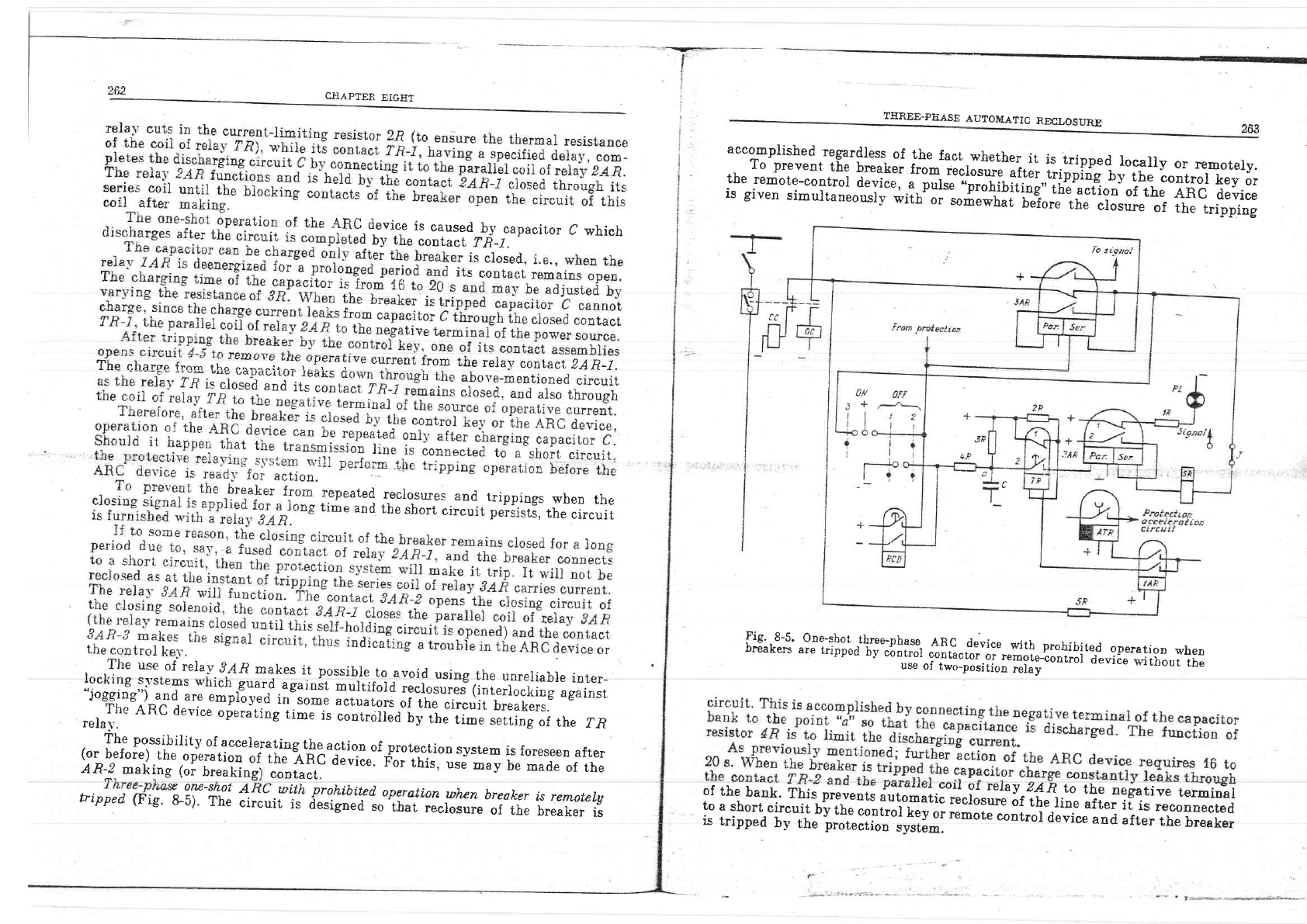
CHAPTEN
EIGET
TITREE-PEASE
AUTOMATIC
REILOSURE
acco*plished
'regardless
of
the
fact
-whether
it
is
tripped
locally
or
remoterv.
'l
o
prevent
the
breaker
from
reclor*.
"itrt
i.ipping
b-v
the
tontrol
kev
or
the
remote-controt
-dryi;;;.i:ru
"p.onftit1ie,,"ii*
action
of
the
ARc
deiice
is given
simultaneously
*itn
;;-ro;;*h;;";;?"#
tl,
cioru"r-;-,
tir"
tripping
I
device
is
caused
b5,
capaci
tar
C
which
rd
by
the
contact
TR_I.'
The e.harro f..,,. ;;;:::^,:."jlo,rp,"ror,rve
current
trom
the
relay
contact
2AR_I.
ted
reclosures
and
trippings
when
the
and
the
short
circuit
prriirti,
the
circuit
The
use
of relay
3AR
makes
it possible
to
avoid
using
the
unreliabje
inter-
locking
s1'stems
*[icit-g""ta'rgu,";t
multiro]JrJc.iosures
(int-erlocking
against
"jogging")
and
are
empl"oy.d
in'some
actuators
of
the
circuit
breakers.
.rrrTl,o
ARc
de'ice
op*ritiogtime
ir.oot.oii;ify
rhe
time
serting
of
the
TR
The
possibilit]'
oJ,accelerating
the
action
of
protection
system
(or
before)
the
operation
of
the
-enc
J-"i;.:'f,;;;;is,
use
may
AR*.
making
(oi
breaki"gl
"ooi""t.
One-shor
three-nhase
1l! .a*ice
with prohibited
operation
v,hen
are
tri
pp
ed
b
v
cb
n t13t
or,ti+:i'
ru'l:i]ifi;;il
i
r:
"Yf'"'*i
tr'
o u
i
T[i
Fie.
8-5.
breakers
is
foreseen
after
be
made
of the
tripped
(Fig.
e
one-snal
AHC
with
pro.hibit-ed
operation
u:h,en
breaker
k remotelu
&5)'
The
circu*
ir
d"sigo"a
ro-tuJ.Lrr"*ir"ol'th,
breaker
i-s
o
r
the
b
a
nk'
rni
s pre'eu
ts
i,,t
o
-
"i
ii"#.ii.ilf
Ir
iur
tll
H"i
:fli:
tli#Hil#
f
ilH:l'ffTiJ||nff,Xtj'l##r
renote
contror
a""ir,
""i
.ir*-"
th.
b;;;k;;
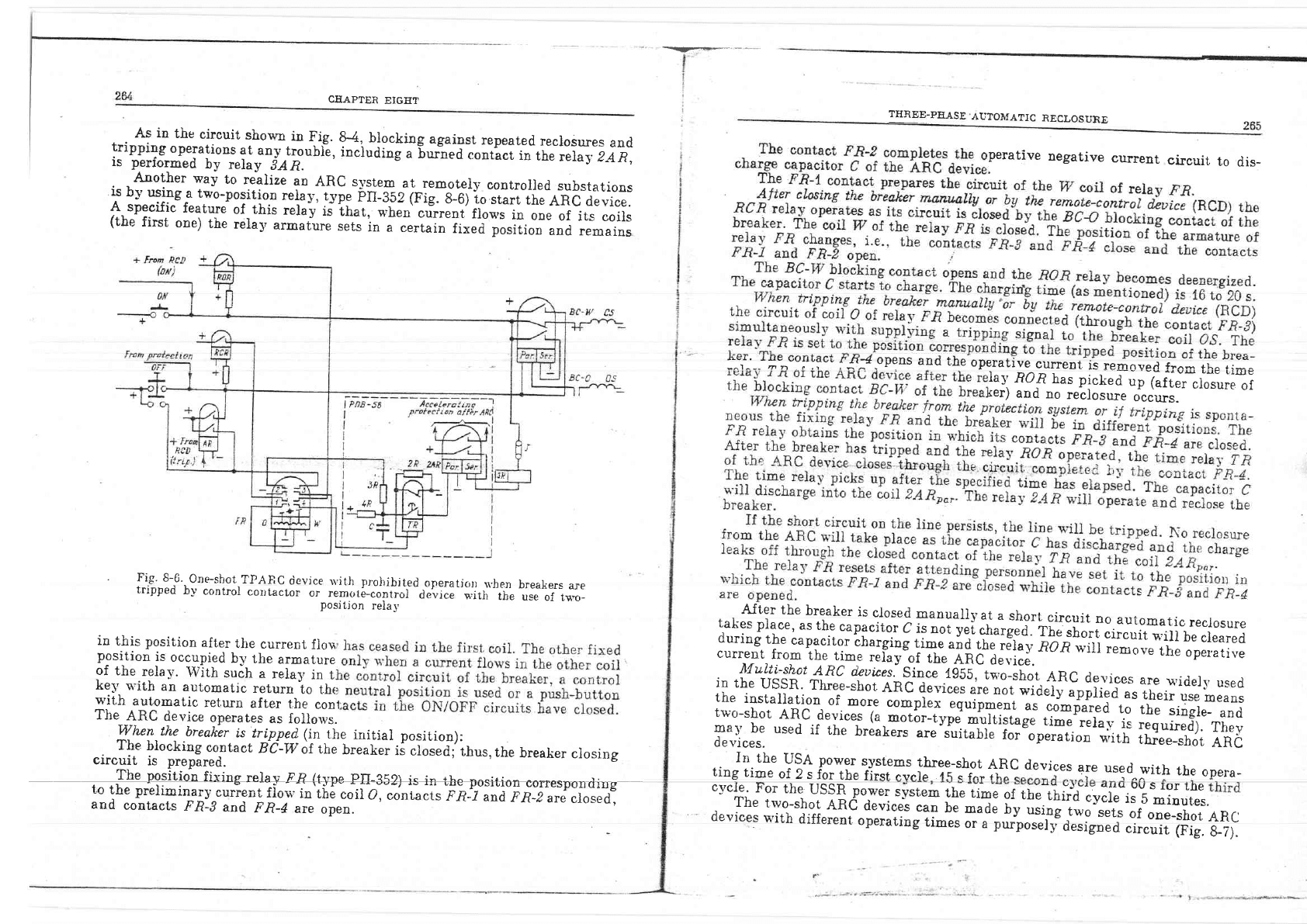
-rlF-lriar*---
CHAPTEN
EIGET
.
Fig.8-6,
One-sbot
TPAIIC
dcvjce
u,ith prohibited
operatiolr
*.hen
breakers
are
tripped
by
control
contactor
ot
re-ul6-*riJ"a"ii""""'itrr
the
use
of
tvrc-
positjon
relal'
in
t,his
position
after
the
current
flou
position
is
occupied
bv
the
armature
of
the
rela\'.
With
such
a
rela5,
in 1
kev
v'ith
an
automat,ic
return
io
thr
with
automatic
ret,urn
after
the
conl
Tiie
ARC
device
operate,s
as
follorvs.
when
the
breaker
i.s tripped.
(in
the
initiar
position):
The
blocking
contact
Bi-w
of the
breaker
iJ"rr*a;'irrus,the
breaker
closing
circuit
is prepared.
,. *#i
jli*l::"51:**y^{{_tl1'1e
-er
B52}js
in
tf1q*i{ot
eorresponding
r,'vrr'"'rsrJ
uurreur,
rru!1
rI1
Llle
coLIU)
COnLaCtS
I"
I7-l and
f'II-2
afe
ClOSed,
and
contacts
.F.R-J
and
FR_4
".,
opro.
y"".:r
l:
t
. *lC.
j
i:1ce;
(a,
mo tb
r_t.vp.'
-ut
ti
rt"
e.
.ff"rt#ft
l:
fj;]l.l"u
used
if
the
breakur.
"..'J"itun],';;;.;d#;J;'""i
devices.
ion
u'ith
rlng
trll}e
oI
2 s
for
the
first e.vcle 45 c fn? rho o
As in
the
circuit
shown
in
{is.
8-4,
blocking
against
repeated
rec}ospres
and
rping
operations
at
any
troubl-e,
including
"
E*-""a
.ontact in the re1et, 2 a R
l:iry:ig_g..ra
tio
ns a
r
an
y
tlo
u
b l*e,
io.i
u
a i"g
"
ntact
in
the
relay
2AR,
is
performed
by
reiay
iaA.
Another
wav
to
realize
an
ARC
s],stem
at remoteiy
controljed
substations
iS
bV
USinS
a tWi-rr.,*if inn ralo., rtrno DTJ e(o /D:- o Z.\ r -, . .1
I^T,-t1s"1^t::p?lilio.r
relav,
t-r'pe
pII-352(Fis.
g--6tro
srart
rhe
ARC device.
A specific
feature
of,this
relay'iiiit"l,-"'nro'^"rii.rrrt
flows
in
one
of
its
coils
UI
I
tS
COIIS
(the
first
one)
the
relay
*t*ttu.r
sets
in
a
certain
fixed
position
and
remains
perative
negative
cwrent
circuit
to
dis_
Avr'
r!E
(/urrLaot
!!. -opens
and
the
operative
cunent-is
reri.,ooj-+"- -i"^;::^-
-^, -- an . ..
ta5,
noa
nJ.';;k'.'fl;;11ft.;fiil;T;
<er)
and
no
reclosure
occurs.
TIIREE-PE.{SE
ALITOi{ATIC
RECLOSURE
f:il":"l.,lll*:::_ql'^":g fi1:illla,t
a
shorr
circuit
no
auiomaric
recrosure
h.lfi
JiX...#:
j*::r*::::gs::iy**:iq$:iriJ!illi:'lJJi,T'1i"r:Tiff
[';
j}'iJn'i,:trii?l1l_"'Hflj:{}T,..";t*loriili;b"dTil::X:TJ#:h:f
iii:
current
from
the_time
rel=ay"ot
th,
ARC
;;;;;;
ll"li f *, #I 9-
(u
t ce
y
rs^ioce .{
ebb,-t".
_.["
t
A R
C
d
e
v
i
ee-s
are
v'idel5'
used
their
use
means
the
single-
and
reguired).
Tliey
three-shot
ARe
i il
":
i :
y:,?l
I l\:. :1,_: { l_g
a,
"
i.*'
a
u
"
"
t
*"i
a J
il'
;o
;
i,#?:
l*:,
_
:*t_"
tl
* X
",
:
t
:. i: 19
*
pi.
*, q
"
i
T";;
; ."
"#_?J.;;
"t
:
devices
qre
used
with
the
opera_
cvclg.
-F'or
thg
US-qR nogJp.r sw.tarr,
+L^ +;*.^ ^r +L-'-
vJvrv
q't.
(rv
s
ror
lne
The rrv.,_"r,^,,iilAT::jlrl*^T
rhe
rime
of
the.rhird
cycle
is
b
minures.
[t3 ;-m *;1.*l,t i::: : : -" 1 t-T r
il ;
;;
"
ffi
fi
1;
;
"*
"
T
".H1.i'.7
d e
v
ices
wi
t
h
d if f
eren
t
o
pera
ti
n
g
ti-;-s
;;
fi
;.#
#
il:h'
;i
J"Ttf,?l
tli8-7).
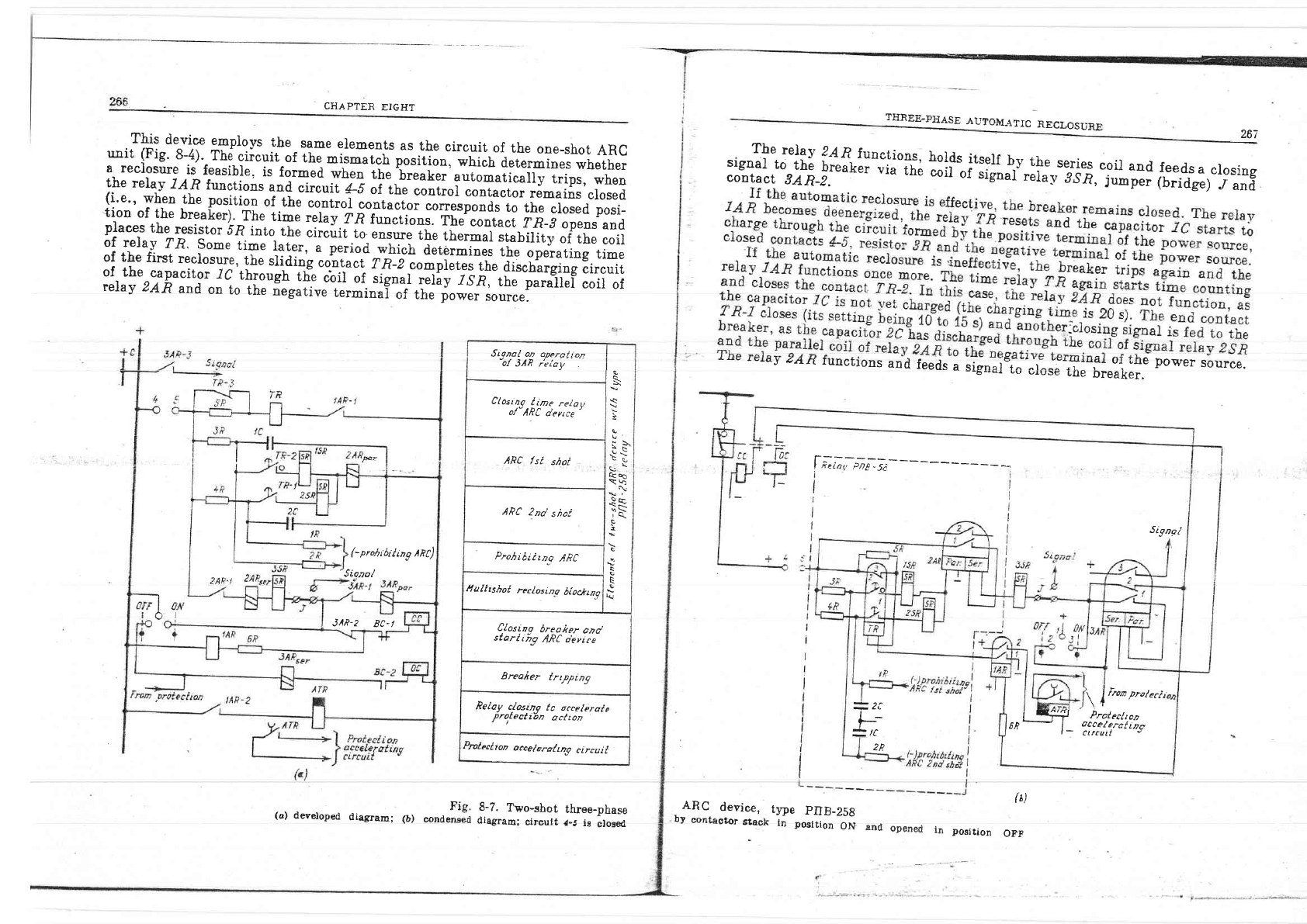
CHAPTER
EIGHT
THREE-PHASE
AUTOMATIC
RECLOSURE
l*
*r'
i
4 !ffi
;#'.""ir
;ffi'
'I??
;l?
#
:i:il
"i
"":""HI;l
T I'-Tiff
'
.illl l
;"#i;h";'iJ';"*i;-Tl*ilY
a- recJosure
is
feasible.
is
formed
wh.en
the
breaker
autometir,.allr.z rrinc nrha-
IH:".?:1T ffi:l:i:*S:,:tT,
elements
as
.the
circu*
of
the
one_shot
ARc
'
The
relay
2'4^R
func'r'ions,
holds
itself
by
the
se^rie3
coil
aud
feedsa
closins
::-"TiJ"r:T_ireaker
via
the
;if;i;;;Ji'"liJr'r,sa,
jumper
(bridse)
-r
and
a_ recJosure
is
feasible.
is
formed
-wheo
the
267
{i;';,"I1f;
:;l;fl ::i'';1".1,*"111i:*i,*{:;:'"*Fffi
i:T',[flilllu.'o1ij,1
:ili":t'H: i:*l* Jl'; : 1T :
"
I'
t
t
n l;"
1
il"*
ffi
";'"'il"
:i';;
;'i;:i#I
places
the
resistor
iifi
into
the
li
Pras'er
ure
reslslor
tfi
into
the
circuit
to'ensure
the
therm.ai
rt"*fiiy
of
the
coil
of
relaS'
f-R.
Some
time
later,
a-period
which
deterrninps rho nnd>a*.ina *.*^
*,r
r'r'Iy
r
rt'
Dome
trme
rater,
a
period
which
determines
the
ope"rating
time
of the
first
reclosure,
the
sliding
contact
TR-Z
comnletes the diceh-,roina ni-^,,i+
ur Lrrv'rst
rcclosure'
tne
slrdins
contact
TR-2
complet_es
the
disct'arging
Eir.oii
of,the^capacitor
Jc
through
tf,e
;'.il
;i;i;iffi)av
.
rR rhp no.oror ^^;r ^+
cbil
of.
signal
reliy
ISn,
the
paratlel
coil
of
e
terminal
of the no'qreT
q^rr.n6
relav
zAR
and
on
to
rhe
i"s,"iiu.
Gff;T
,f
ffi
;r#i;r;r"r:.:
Stanat
oD onpralion
"o/
JIE
it"y"-.
lc
\
\
lr- \
\-\
a<
oo
\v)
.tR
e>
i
c
\
Clostn,g
lime
relau
o/-ARC
deytcp'
ARC
fst
shot
ARC
Znd
siot
Pro.hibittnq
ARC
Hallzshot
reclosinq
ilioclnq
Closinq
brea*cr
ond
starltitg
ARC cievite
Breaier
trtTping
Reloy
closinq
tc orcelerale
protecti-an
octton
Prolectton
occelera/
tng
circuit
Fig.
8-7.
Two-shot
three-nhase
condensed
diagran;
circult
l-s
ls
iloged
contact
3AR-2.
'ar
vr
drHrrar
reray
Jb'Il,
jumper
(bridge)
"r
""8
*4v
rsrav
'Att
tunctions
and
feeds
"
rlgnul-;}"*
#JTifi;i:
power
source.
contactor
remains
closed
f
R";;nt
-ia---*-
------:
Signq/
t-
r-
ltf
and
opened
in
.
ARC
device,
rype
pnB_25g
Dy
contactor
6tack
ln
position
ON
(t)
OFF
(-prohliting
AFt)
Sionol
JAR.2
BC-/
'1lr'*
n*tort
i i'?r
proiecitcn
Ot-
1
occelerattac
|
-
carcatl
(a)
developed
diaeram;
16)
posi
tion
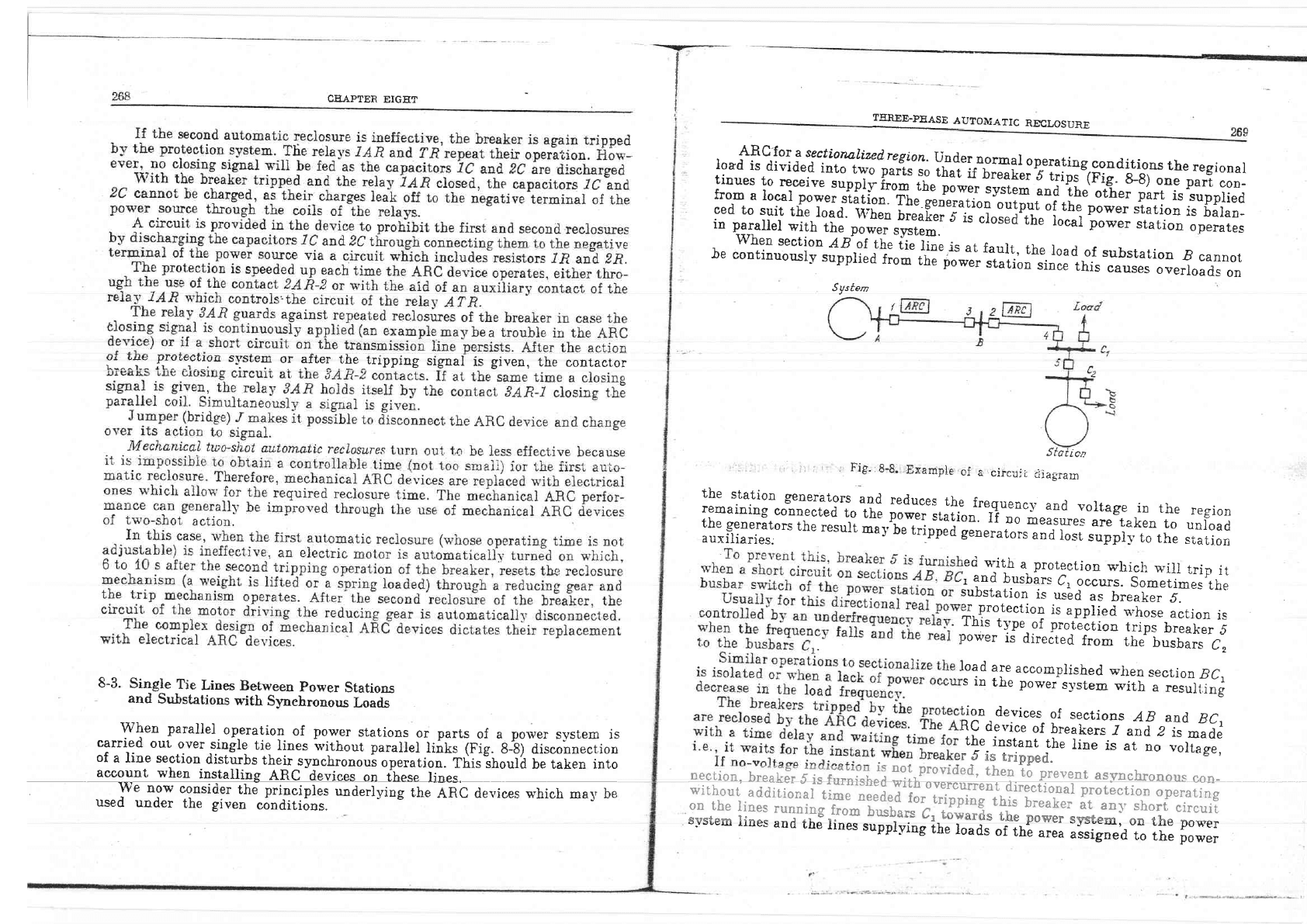
CEAPTER
EIGET
I
I
I
i
I:^:T-: L',l"_'''"ly'DJ!'sLv!.r
o-r
-arLer
rne_rrrpplng
srgral
is
given,
the
contactor
8-3.
Single
Tie
Lines
Between
power
Stations
and
Sulstations
with
Synchronous
Loads
T4""
parallel.
operation
of power
stations
or parts
of a
porver
svstem
is
carried
oul
over
.tioelg
tie
Iines
'without
parallei
ri"ti (Fig.15i
d.isconnection
of
a line
section
disturbs
their_synchronous
op.t.tioo.
This should
be taken into
TEN3E.PEASE
EUTOMATIC
RETLOSURE
f
*Tif
fr'",r*?y!:::d::51"i:ylt.raormarop_eratingconditi
ions
the
regional
ll* :'.9, :
q: q
i
"r"
-ryG##
;;
;il,"
ir";;,Ti::
?T:l
li:: : l: i
;:
:: :*;j
i
ffii:
#'
T:
l'f'
"',*
f
f
#'
?i
J T1';" l3l,:-":. r:T ? i{
fto.-
a local
power
stition.
The
the
other
part
is
iupplied
he
power
station
is
bilan_
:"'Tiif
ifil#flil,Tl;Ii;r:l';t'J,.*'*#il*"o_iE;J'?iil,L'if
l,1:::
r;
efiri.'i
#t'
ri:'
r:#l
i,l?:[|"
is
crose
d-
the
rocar
;;;;;
;;"r
t""
:r:il?:;
when
section
AB'of
tht-i;ffie-is
at
fault,
the
ioad
of
substatioa
.B
cannot
be
continuously
supplied
f;t;;h;
power
station
since
this
eauses
overioads
on
Stattcn
Fig.
r8-8.
Example,oi
a
.circuii
iiagram
the
station
generators
and
*dl:u:,
the
freg-uenc-\,
and
voltage
-in
the
region
remaining
connected
to
the
po*tt
station.
iilo
*.rsures
are
taken
to
unroad
:l'reff:,Hlors
the
resulr
mav'be
trip;;;'a*"iJru
r"a
losr
suppil,ro
the
starjon
Led
*'ith
a
prorection
whicir
lv.iil
trip
it
,
and
busblrs
C,
occurs.
Sometimes
the
substation
is
usbd
as
breaker
.5.
er-
protection
is
applied
n,hose
action
is
This
t5,pe.of
prot,eftion
trip*
l.L"f*..
.i
rower
is
direc,red
from
tne
lus[il?;
load
are
accomplished
w-hen
section,BC,
's
in
the
power
s-vstem
s,ith
;;;;l;;;
bion
devices^
of
section
s
AB
and
BC,
RC
de'ice
of
breakerrT""a
Z-;;;J
the
instant
the
line
is
"i
oo
"ott*g.-
r
_5
is
tripped.
r
r
ls
rripped.
nectioo,b';"k;;fi
ffiffi
["#"-H$l!*il;,lt?Jr1fi
:'"""',T,:;#,',H"r;]:r,"J;
without
additionar
time
ne;J.e'i;r
;+"
'{
r#'brrrk*
it
an1,
shorr
circuit
on
the
lines
running-f"";;;;b;*
",
towards
the
nower s-,qrorn nn *,.a
Svstem
account
when
installing
ARC
devlces
on
tnesr
riaes_-
wffi
prlnclptes
"oa"rtviog
tu.
an-de'ices
v,'hich
ma1,
s,
used
under
the
given
conditions.
svsrem
rines
and
'r.hj
rines
*pprri"s
ir*
rolJ,
"Tlnl""Til
:Hffnh";
11'
f;:;:;

270
CHAPTER
EIGIIT
rEREE-PEASE
AUTOMATIC
NECLOSURE
arc.
,To
make
automatic
reclosure
operation
of thp
qrrrnmo*i^
,,^_-..^.1rlT.effective,
it
Tust
be
oombined
nith
the
HJ,1:r[ijJ':].^,"_,*lTiT,_l:,"_,_'-
;hil";;;lioi,Jnlijr;;
:f:ii_",,1,]:,1"t::
#:l;:,l"JilX1-,:,t*l't;S;lll"*::":':ffi;*##;iltT;,.?,e";"".f
llli,llf",
*'B:'::JH;r"'l',Ti',"":i:l-"*^l?:;';;;r{il;:?::ii:x'"J:ffi
i
l:":tT:??:*illifl
"j::;;"il^s#;ritiiifi
",i:?''irr_:it,o,synchro-
""H_;:iu^o;"..f.:.u.111:H:l:tr{td!l;;1ffi
il",',"*f
Ht;lf":i;Tf
:
fi H""
;
li,':,Y::i I f::
ol
* i'*",T +^t'#l
ff
fi ;':";
;i,3.'
":-1
iil'j'
"
t h e
ttipppg
of
the
supply
tio..
lisUo
quuuruaLrc'
crevlces
respond
to
the
dervoltaoe
relew nr rho raani,,i__ _
y1be.
noted,
however,
that
the
rise
of
an
uD_
H,""""t:",T#1gi,',1."*;1S"#;;;,"1;!;:ffi
?,;:TJ,i?,:,T"?f
,:l,il"
3ll'"H"ili::,*T":T1-::tls:1ith"ilfi.,il;5?:"";3:Hi'"'Tilil#3it
;iii?:",T,*t''*#i:Tl'"Xl?;,'":j:,:*itt+Tiilir*""eilt"d-H:ffi
liff
F.t"l,t:.if :r'"1::0,:o,.,,od..-';;;;ffi
'#;;:;t"ff.t::,,l;;:li"r:'H'll
forcing
the
excitation.
271
ith
automatic
deuices
remaui.ng
ezcttation
en
the tupply
ol the
substatioi
i"s
stopped.
t,
Supplv
ltne
t/
V
I
tt
Receivinq
sulstoitot.
/\
taJ
Fig'
8-9'
Changes
in
frequenc\'-
on
-terminals
of syrrchronous
capacitor
after
,
rrippir:g
the
supply
line
.
(o)
suppl]'
circuit;
(i')
relationship
between
freguenc].
anc
time
lpplied
through
transmission
lines
fron
c_apacitor
to
maintain
the
busbar voltage
!\rhen
the
line.
is
tripped
at
the
,uppi_o
'9)
or the
svnchronouj
motors
instaliei
revoh'e
due
to
inertia.
The
resuit
mav
s
and
the
excited
sl,nchronous
machinel"
e.
This
causes
asl'nchronous
connection
)rques
in the windings
and
on the
shaft.
igned
to
operate
under
such
conditions.
;pe9d
s-"*nchronous
motors,
have
starting
lation
rnay
fs
obtained
unless
the
excil
rlreferore'
ror
ellecttve
automatic
line
rec]osure
the
reclosure
time
of the
breaker
from
the
suppiy
side
must
U.
gr*"t.r-*""*tir.
total
time
tat<en
by trip-
ping
the
synchronou-"
load
or removins
the
excitaticn
and
ext,inguishing
tlie
ni
%
I
,al-
I
f
20-
-^r^!h:
fi'rst
metluod.
The
tripping
of
the
srpplv
line i.s dpreerorr lr-, - f-^-
ruray
respondrng
to
the
freguencv
of
the .rntt o.o -";;;;;:-^;*r-"_'.i^^'-'_9s:uuy
nous
motor"s
or
synchronoui
caplcitors
(SCj.
-"
'rvu
'J
tuc
syrcnro-
.*p"*Y;lotoo
the
supply
is
tripped
the
speed
reduction
of
these
mechanisms
is
given
by
the
dA.^
Attt:#
lces
(&1)
(8-21
(&3)
(u)
(8_5)
1.6
t.6
.t
I'Iiere
Aor,
:
orz:
l4tithin
a
be
regarded
with
f,
14
s
Figure
8-gb
shows
is
seen
from
the
fig,:re
de.creese
il
-tbe
engrjar
speed
;i'f
ffi
loX*,lt"ltt*een
the-emJ
vectors
of
tbe
synchronous
capacitor
(motor)
10
to
2.0
fer
cent
speed
reductjon
as
.belng
uniformly
retarded.
the
rotor
of
a
synchronous
machine
may
then
6,,:*
#++
u
- ^
n
t
in
Aio-
j6r.
:
{,
:
,n
,
dt
Pn
Tin'
iiii
T;1.*i;T:ru""r1."irl;rlientase
relative
to
rhe
ang'lar
speed
or
the
normar
berore-
La/s:fi
$y,
no
with
different
p
t/pn
ratios.
It
the
supplV
lin;,
the
frequu"ry
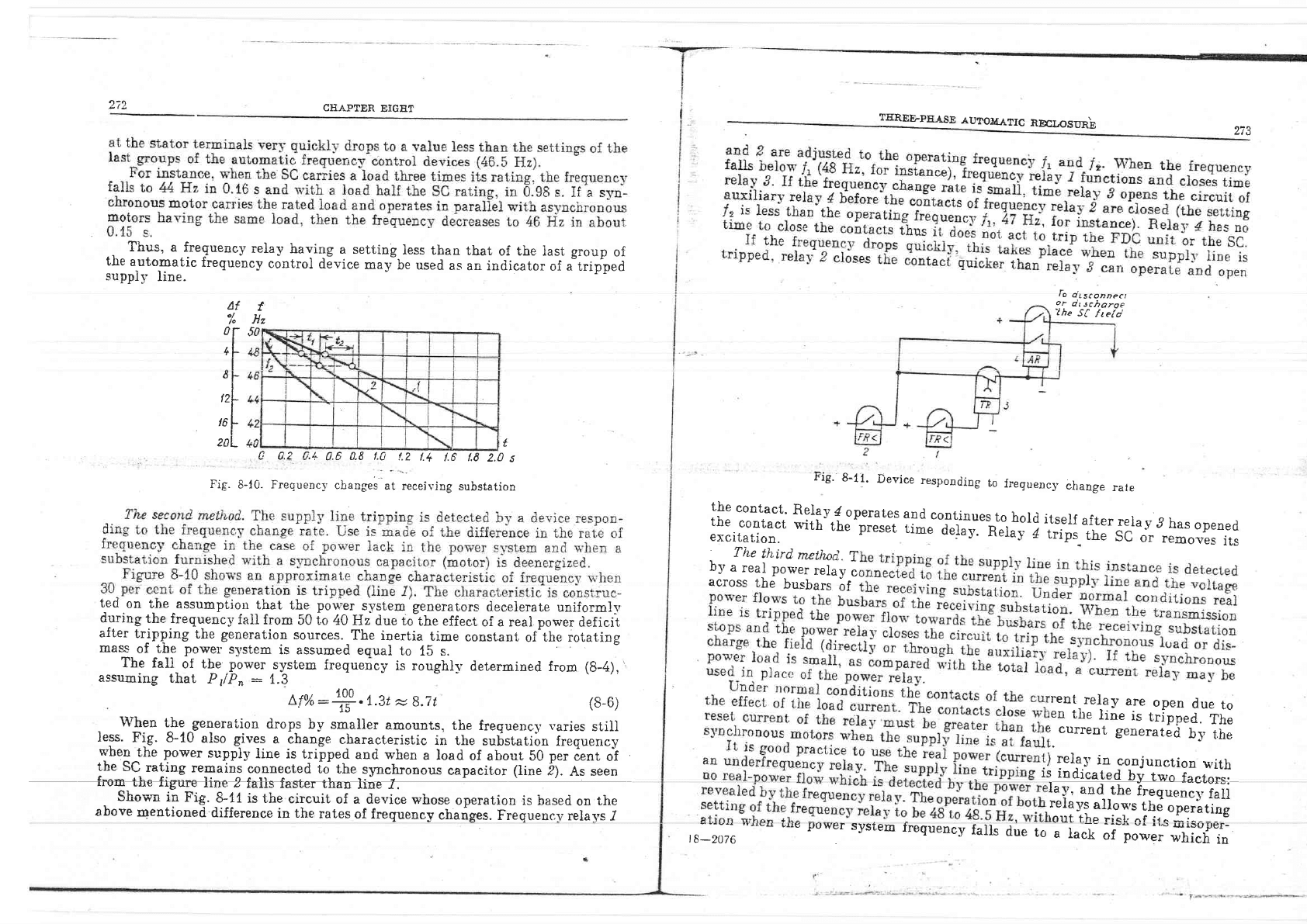
,i,
CIIAPTER
EIGET
..,.^Th:t,
a.freguency
relay
having
a setiing
iess
than
that
of
the
last group
of
tne
autonatic
trequency
control
device
may
be
used
as
an indicator
of
altripp.d
suppiy
line.
0 0:2
g.+
a.6
0.6 La
!.2
t.+
t.0 t.6
2.0
s
Fig.
8-10. Frequency
changes
at receiving
substation
ted
on
the
assumption
that the po\rrer
system
generators
decelerate
uniformlr
vvu
vu
uDv
qooulrtsurr_--_uTor,
Lrl-e
Puvvtrt
DySLern
gelrBlaLors
ogcelglatg
unilol.mlJt
during
the frequenc-v
fall from
50 io
40
Hz due tolhe
effect
of a
real
Dower
deficii
after
tripping
the
alter
tripping
the generation
sources.
The
inertia
time
constant
of-the
rotating
mass
of
the
power
svstem
is assumed eouel tn 45 s
power
system
is assumed
egual
to
15 s.
The
fali
of the poTver
systen
frequency
is roughll'
determined
from
assuming
that
P
/Pn
:
{.3
Lfo/o:#.
t.3t
x
B.Tt
\tr'Ih9n
tlqg.l*tat,ion
drop-s
by srnaller
amounts,
the freguencv varies
still
less.
Fig'
8-10
also
qivgs
a
cbange
characteristic
in the
substation
frequency
when
the-power
supply
line
is tripped
and when
a load
of
about 50
per
irttt
oi
the SC.
rating
remaios'connected
io
tire
s;mchronous
capacitor
(Iine
i;.
A. ,.un
Jrem
tlre figrereJine.
2
frlls fasterthal
ti.nffi
Shown
in
Fig.
8-11
is the
circuit
of a <ievice
whose
operation
is based
on
the
above
nentioned
difference
in the
rates
of frequeucy
changes.
Frequenc._v
relays
.Z
t
Jlz
50r
Af
o/
il
I
dF
,rl
'u
l-
20L
(8-4),'
(8-6)
t
TEREE-PE-{SE
AUTOU.ATTC
ngCf,OSUnb
LIJ
Fig.
g_11.
Device
responding
to
frequencl,
change
rate
the
contact'
Relay
4
operates
and
cont-inues
to
hold
itself
after
reiay.?
has
opened
:li,ff;:i:i
rilith
tn'
t..J
iiJ.'
;-J*-R;iiry'I'r,ips_
rhe
sc;;
removes
irs
Tirc
th,ird
m.etlnti.
T
by
a
real
power
relav
c
across
the
busba.s
of
'rent,relay
are
open
due
to
Len
the
line
is
tripped.
Tli!
l.
current
generated
by
the
)
relay
in
conjunction
with
;
indicated
by
two
factors:
Iffi;;;;;i
rela1,5
allos,s
th,i
oper'"t#
.,^rvu
b.,'
rruwer
svsrem
rreguency
falrs
due
,ot:"i"r.hk"
Iirl;;;.#t'ilf1i
t8-2076
fo
citsconnect
or
dt
scharoe
-the
SI
f teto

274
CIIAPTER
EIGET
its
turn
speeds up the
change
of
the
synchronous load
to
operation with
removed
excitation
(or
the tripping
of
this
ioad), i.e.,
makes
it
possibie
to
speed up the
action
of the
ARC devices from
the
supply substation side.
The
variants
of
the
circuit
of a device which
automaticaliy removes
the
excitation
of the
SC
w-ith subsequent
reciosure
of
the fieid
circuit, after effective
autonatic
reclosure
of the supply
line
are
iliustrated in
Figs.
B-12 and 8-13.
Asgnchronous
ARC
d"euices
use
the
same
eircuit
as
the
AFC
devices
on
the
transmission
lines
supplied
at
one-
end.
The-.i-pii"ity
"oa
-rJiJii.
operation
of
such
ARC
devices
lccount
tor
tnri.
L;;;"itj';
suppried
from
borh
end.s.
TTREFfPEASE
AUTOMATIC
RFCLOSUNE
275
Tc
o'zsccnnect
taL
aevtce
To
connect
fDC
deytce
To
disconne:! svncironous
'tu
s
.:J
\s
OU
R*
from resistor
in
exctlo.t.i
on
vinaing
frcm lrt,ond
.2nd
voliage
tronsfornters
from
/st
cnd
Znd
rolta-oe
transfortnes
Fig.
8-12.
ARC
device
of synchronous capacitor
J
--
voltage
re)a5;
2
-
underfreguenc!
relaT; B and 4
-
time
relays; s
-
axilian-
rela-\';
o.
-
relal' delayed in
reset; 7-9
-
Eeries
resist,ors;
j0-ta
-
signalling relays;
J4
-
s$'itch;
ti
-
contact
on the
main breaher
(closed
when
breekei is
turned
oi.r):
{f
-
Jumper;
PR
-
contact
of
real
power
rela;- used in
supp}l'line
(closed
when line is
dlsconnected
and no
power
flos'toward
receiving station).
E'hen
r€)a-\
P.R
is
used
the
circuit shown in
broken line is open
The
excitation
is reapplied
either
after a specified
time
(provided
the
busbar
Fig.
8-13.
ARC
device
of
sl,nchronous
capacitor
i:ililTi.._,-"fiiI'"i;y9;ii;To"f,X",L'lf
u"i:,.;F;i"",':l!"_*r:r,!gnr);o:z:-
3.e
-.
psispll.';i:lifop"r;
pr?
-
conree-t ,lFllii':'^1,;'-t^{lltlll-s,rptals;
;i--'si'iiet;
auxiriary
ieiays;
t an,r
s_idiiy-,'o-Jii"v"o';
s:ri?4r;'1.,[?xil[t:s1Jr."€l']:1!Lf;;"L
if*1iff]&'T,lii [niTtiib,{*];"i*jfrt"rr--rea:.
n;;"';;i;;'iled
in
circut
or
suppry:
reiay'-Fn-i;;;"d"fi;
crrcurt
shown in
"*u1,91?ljl,o-$^J9l'ald^receivlrie
iiati;;j."if'fr;;
.\
rEr.t/b;
6 ano_g
_
rejaTe
delayed
in
reset;
:a--z+
_liqii
Jd
-
resistor;
J7
-
lu
lrne
(ctosed
when lini ,?Bfli^fj^;^"gll"c_t-
ot
rea:--.no-",",
..i,ji
it{'"
tirgr_ud.;:t;
lir6;'fi;irffi.;"f:ilicl
or
real power
relav
us&
inAii'ciit
or'
reiay'-Fn-i;;;ui"fi.
crre'rr
qhnwn
i-
"-^,.L9191
^flow
towarci
recei"lrie
iiatibij.
reiay
P.R
is
used
tle-circuii-s'n-"if
iii"u'iXl
P'*-9'
rrov''
towaro
tec,llllq
ftluonl.
v'ifen
brearer
/clo^p_rt _u,. ,*"tjllgjr.o-p9l:
l9C
_.cont6ct
on_i[b
biiii
breaker
(crosd
wiien
tnJ
irAi"r:
i:";ilr€j
*l
voltage
of
the
receiving
substation
is
restored
(Fig.
V1,2)
or after a speed
close
to
the
s-vnclr.ronous
speed
is reached
(monitored
b5'relay
8,
Fig.
8-13).
If
tire
voltage
fails to
recover
u'ithin'the
specified time,
i.€., t,lie automatic
reclosure
of the suppl5'
line
is
ineffective,
provision
is made to trip
the SC.
Helay
8
responds to the
current in the
rotor
s'inding.
It
is
an auxiliary
relay
with
delayed armature
dropout.
The frequencv
of
the
rotor
current
pulsations
tn'it
er.ice
tripped
couesponds
to the
slip
value.
The FDC
device
is turned
on
at
a slip equal
to 5
per
cent. Relav
9 ensures
the single
action
of
the
nulse closing the FDe
deviee-
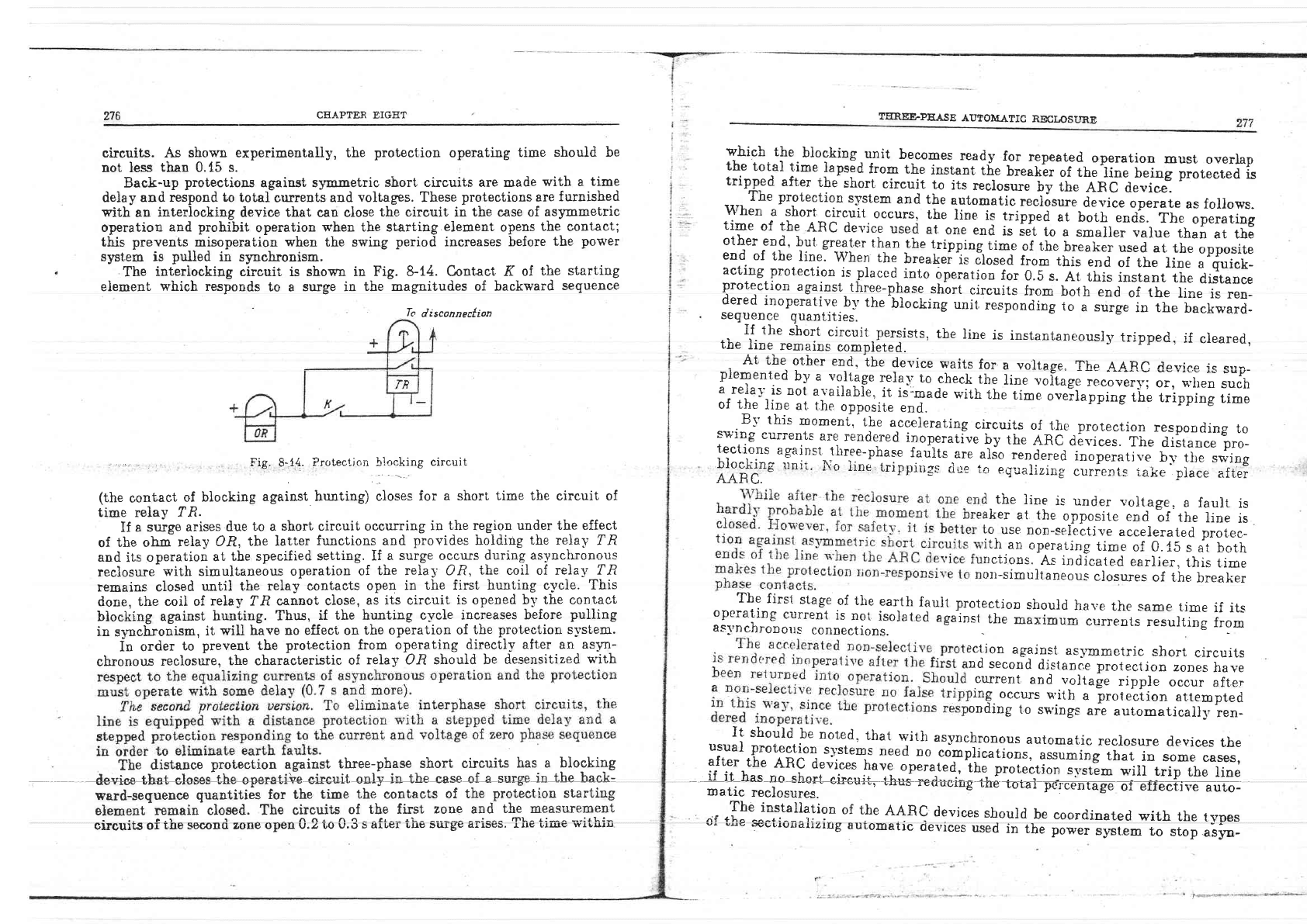
The
distance
protection
against
three-phase
short circuits
has
a blocking
de+iee
thet+Ioses
+-heeper+ti+e+ir+uit
o:rlyjn
the case sf
a sr:rge
in
tbe
ttack=
ward-sequence
quantities
for the
time
tbe
contacts
of the
-protection
starting
element
remain closed.
The circuits
of
the first
zone
and
the measurement
CEAPTER
EIGET
circuits. As
shown experimentally, the
protection
operatiag
time
should be
not less
tban
0.
t5
s.
Back-up
protections
against symmetric
short circuits are made
with a
time
deiay
and
respond to
tofal
crurents and
voltages.
These
protections
are
f
uruished
with
au
interlocking
device that can close
the circuit
in
the case of
asymmetric
operation
and
prohibit
operation
when the starting
elenoent
opens
the contact;
this
prevents
misoperation when the swing
period
increases
before
the
power
system is
pulled
in
syncbronisn..
The
interlocking
circuit is showa in
Fig.
8-L4.
C.,ontact K of
the
starting
element
which responds
to a
surge in
the magnitudes of backward
sequence
To
disconnection
:
..
..
.
,
Fig.
8-,1{.
Frotecl.icn btllkine
circuit
(the
contaet
of biocking
against hunting)
closes
for
a short time
the circuit of
time relay
T
R.
If
a surge
arises
due
to a
shorf circuit, occurring
in
the
region
under the effect
of
the 6hm
relay
OR,
tbe Iatter
functions and
provides
holding
the rela1,
?,R
and
its
operation
at
the specified
setting.
If
a surge occuls during
asynchronous
reclosure
with sirnultaneous
operation
of
the reiay
OF,
the
coil of relar'
?.R
remains
closed
until the
relay contacts
open
in
the first hunting cycie. This
done, the
coil of
relay f"R
cannot close,
as its circuit
is opened
b]'the
contact
biocking
against
hunting. Tbus,
if the hunting
cycle increases
before
pulling
in
s-r.nchrouism,
it
wiII have
no effect on
the operation
of the
protection
s1'stem.
In
order
to
prevent the
protection from operating
directly
after an
asyn-
cbronous
reclosure,
the
cbaracteristic
of
relay
O.R
should be
desensitized
n'ith
which
the
biocking
unit
becomes
re.ad.v
for
repeated
operation
must
overl,ap
the
total
time
iapsed
f.om
theinstant
tfie
breakir
of the-Iine
being protected
is
tripp-ed
after
the
short
circuit
to
its
reclosure
by the
ARc
a*"i"".
The
protection
system
and
the
automalic
rlJot*.
devile
op"r"t"
a-s follows.
when
a short
circuit
o"rut*.
inr
ii"rl1
.;;rffi
at
borh
ends.
The
operaring
time
of
t'he
ARC
device
used
at,
one end
is
srit
to
a
smaller
vaiue
than
at the
other
end.
but' greater
than
the
tripping.
time
of tle
breaker
used
at
the
opposite
end
of
the
linel
when
the
breatei
i-"
Jlosed
from
this
end
oi th;
line
a
quick-
acting
protection
i's
piaccd
into
operation
for
O.is.
At this
instant
the
distance
protection
against,three-pha-se
shbrt
circuits
from
both
ra
of
tne
line
is ren-
dered
inoperitive.blr
ths'blocking
unit,
re*sponding
to
a surge
in the
backward-
sequence
guantities.
If the
short
circuit-persists,
the
line
is
instantaneousiy
tripped,
if
cleared,
the
line
remains
comnleted.
Ai
the
other
encl,
ihe
device
waits
for
a voltase.
The AARC dpwin.p ie er.!n-
lr-r^T::1"^o-!y
r vottage
rytay
ro
check
it.
iio.-
n;il;d;;.;;;;i;
;;';;;";
#;;
a
rela-v
rs
not
available,
it
is;made
with
the
time
oveiirppi"fiilL
iripping
time
of
the
line
at
t.he
opposit.e
end.
"*,.,3j'.:,1i:,T:Tunf,
tbe
acceleraring
circuits
of
the
protection
responding
ro
--*rrjH
uuf.renr,c
are
rendered
inoperative
!y
the
ARc
devices.
The
di'itan;;r;:
tections
against.tiiree-phase
faults
are
alio
ren-dered
inoperatir*
n.1,
ti*-rJirg
HSa:-
iinit.
Iiro iine,
trippiii3s
,ruu
to-",qu"il;i"g
curients
iake'place
aftei
1
the
line
is
under
voltage.
a
fault
is
rker
at the
opposite
end
of the
line
is
Lo
use
non-selective
accelerated
protec._
ith
an
operafing
time
of 0.15
s
at
both
nctiors.
A-q indicated
earliei,
this
time
on-simultaneou-s
closures
of
the
breaker
The
first
stage
of the
earth
fauit
protection
should
haye
the same
time
if its
operating
cument
is
not
isoJated
against
the
maximum
currents
resulting
from
ast'nchronort-"
connections.
u4
vurrFuLD
,'
E
:ction
against
asr,mmetric
short
circuits
nd
second
distanc.e
protection
zone.s
have
current,
and
voltage
ripple
occur
aft,er
ring
occurs
u'ith
a proteciion
attempted
onding
to
s*'ings
aie
automaticall],
ien-
It
should
be
noted,
that
witir
asynchronous
automatic
reclosure
device-s
the
usual
protecticn-
system-s
need
no
coynlicatioor,
"rru*ing
that
in
some
c&ses,
after
the
ARC
devices
have
operajed.,
thq-p;;;;c-rion
s1'stem
will
trip
the
line
'
if
il
has
no
shs+t
eireuit-
thuf*ducing
ttrJ
i"t"rl##;iffiiof
effectjiG
auto-
matic
reclosures.
^- -Tlt-l-".tt^{llll:t
of the
AARq
devices
should
be
coordinated
wirh
rhe
t'pes
v^
sue
rv./L,ruuarrzrng
au[omatlc
de\]ices
used
in
the
power
s]rsteB
to
stop
";i_-
276
TEREE.PEASE
AI]TOI6A?IC
RECI.OSURE
..1 1 - Adr-.r
/)^-fu^-rL^
^-:^^^ mL^a:*^-.:+Li-
clrcullsorf,Ileseconozotreopenv.zLo
u.,f
saMI
uuuDlu'gt
artstis, llrtturlrrE
wr.r,rurr
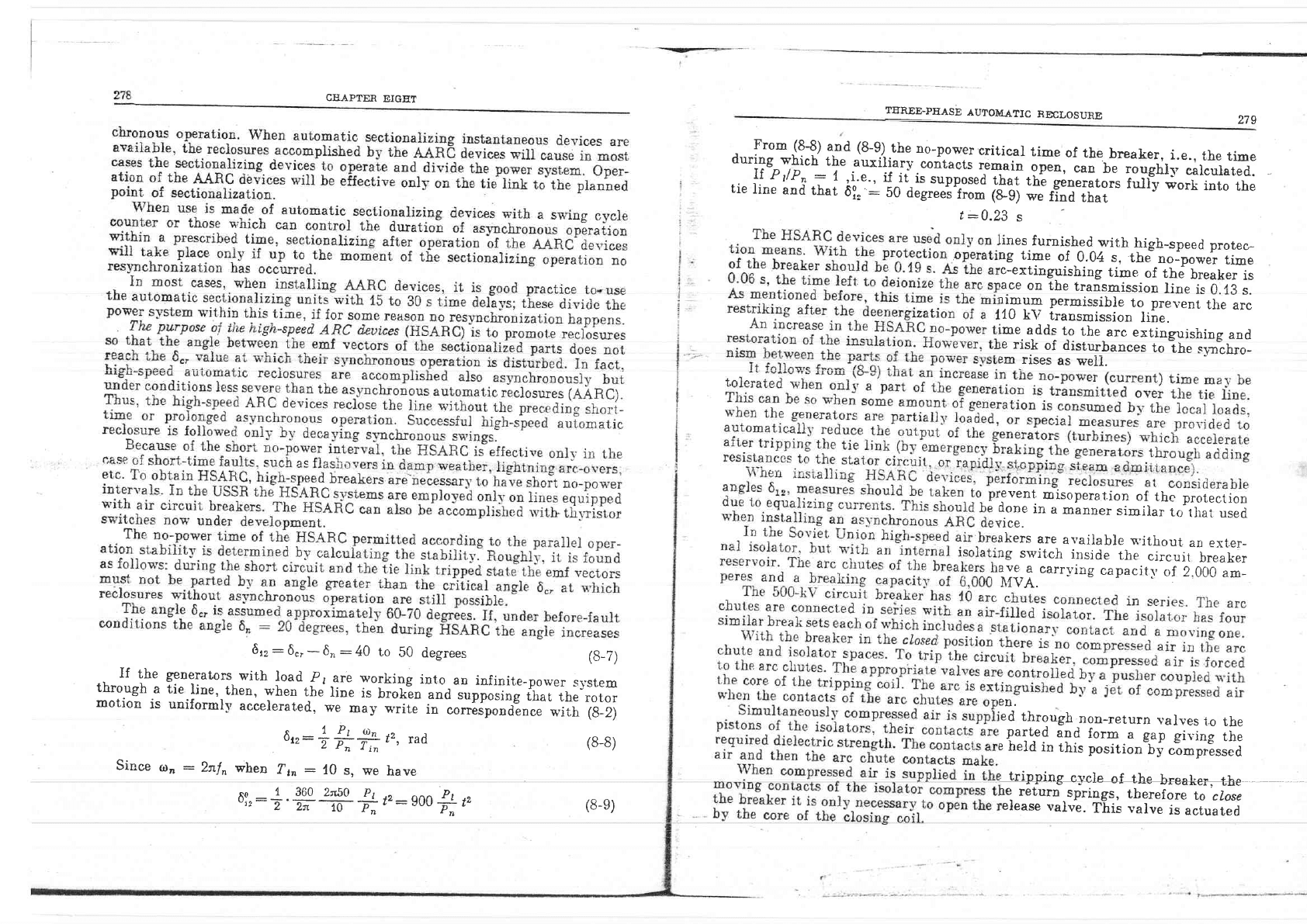
CITAPTER
EIGTT
TEREE-PEASE
AUTOM]+'TIC
RECLOSUNE
279
From
(8s)
and
(8-9)
the
no-power
critical
time
of
the
breaker,
i.e.,
the
time
during
'*'hich
the
auxiiiarv
contacts
remain
open,-;;G^;;ghi'
caiculated..
-
Ii
PIIP,:
I
,i'e.,
iJ
i;
is
supposed
thaf
the
_generators
fuliy
work
into
the
tie
line
and
rhat
61,
:
50
degree-si;;;
ati)
;,
find
that
t:0.23
s
lines
furnished
with
high_speed
protec_
ng
time
o.f
-0.0A
s.
the
no_power
time
'c-exti:rguishing
time
of
thtj
breaker
is
race
on
the
transnission
line
is
0.13 s.
rimum
permissibje
to prevent
the
arc
10
kV
transmission
line.
lme
adds
to
the
arc
extingtishing
and
Le
risk
of disturbances
to
f,he
*y-n?bro_
rm
rises
as
weii.
,event
misoperat.ion
of
the
protection
done
in
a
minner
similar
to-iti"i;;;;
tice.
rkers
are
available
s,itiiout
an
ert.er_
ng
switch
inside
the
circuit
breaker
ave
a
carr_ving
capacitv
of
2.000
am_
]\{VA.
en.
ed
through
non_return
valves
t.o
the
nartef
and
form
"
q"p
giving
t,he
s
heid
in
this
position-by
cimpr"esscd
r
tripping
qrcle
sf
+he
l+reali+rJle
he
return
springs,
therefore
to
close
:elease
valve.
Tlis valv*
i=
,"iurilJ
If
the
generators
with
load
P1€re
working
into.an
infinite-power
svstem
through
a tie
line,-then,
*'ULo
tr,.
Iine
is
Iror,?o
""d
supposing
tirat
the
rotor
motion
is uniformll'accelerated,
we
may
write
in
correspondence
with
(g-2)
6rz:
+i:+P,
rad
Since
&1,
:
2nln
when
?h
:
i0
s, we
have
6rz:
6.,
-
6n
:40
to
50
degrees
(8-7)
(8-8)
61,:+
##f,*:eoof,,,
(8-e)
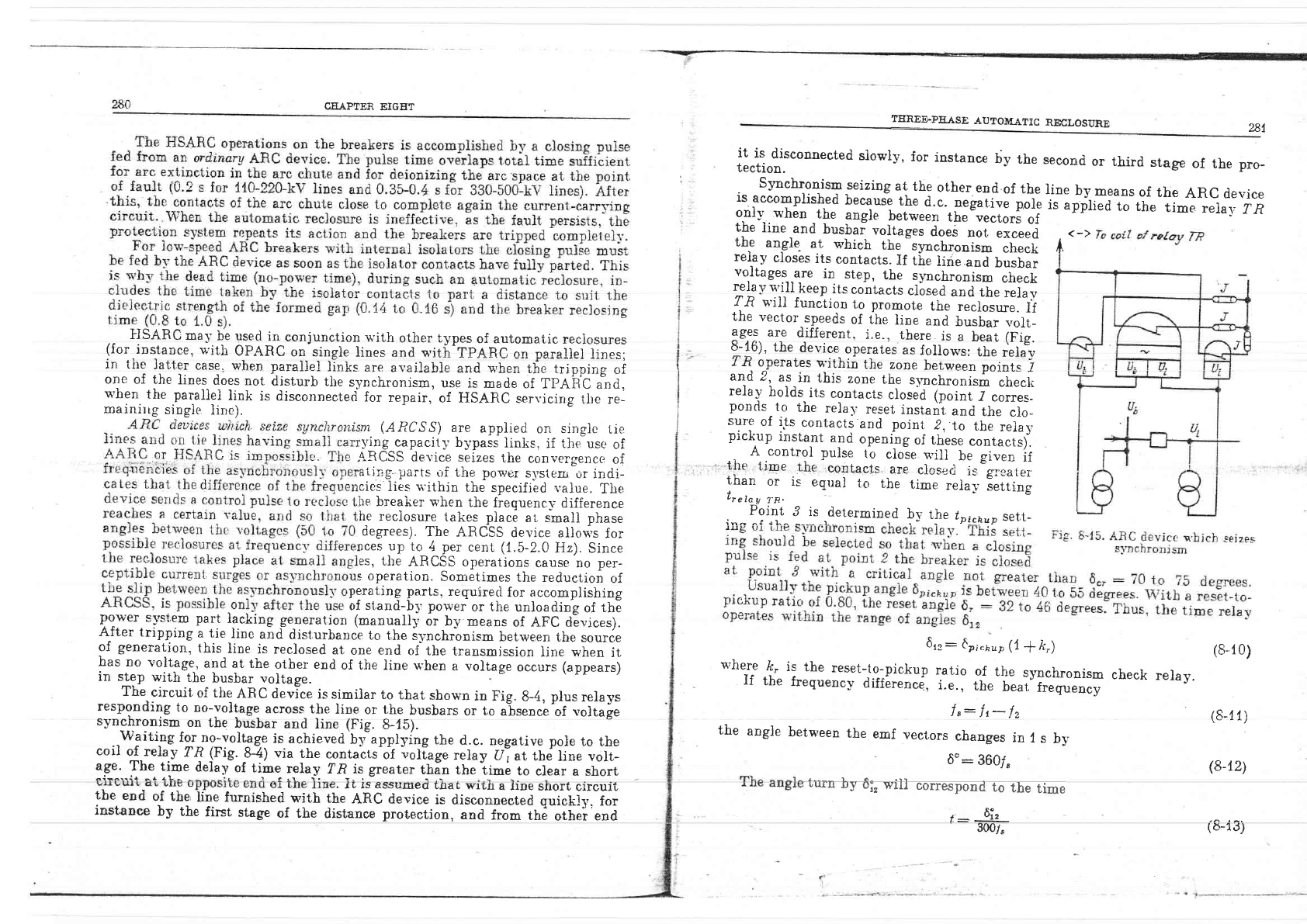
CEAPTER
EIGBT
TEREE.PEASE
AUTOMJ.TIC
R&TLOSURE
?al
FISARC
ma1:
[s
t5ed
jn
conjunction
with
other t-vpes
of automatic
reciosures
(for
instance.
with
OPARC
on
sinsle lines and
q'ith-TPIRC
nn nnretjpt lince.
in
tlie
Jatter
case. when narallel linl'" Arp r.'o;l"hio '-i-*'r.-"--;d;;;:,;^;i
on
e
of the
}ines
doe-s
n
6i e; ;rr;;-
;i;G;;il
;;
;
;r-
;;
;;;'
";'ipi
frt"f"
;;
v'hen.
the parallei
link
is disconnected.for
repair,'
of HSARC
servicirrg
the
re-
mainirtg
single
lirre).
'nL
(,4PC.9.S)
are
applied
on singlc
tie
_ving
capacity
bypass
links.
if tire use
of
{RCSS
device
seizes
the
convergenccr
of
a1.irg parts
uf the power
sl,sten
or
indi-
cies
lies
ri-ithin
the
specified
value.
The
Lre
breaker when
the
fiequencv
difference
he
reclosure
takes
place
at smal]
ohase
degrees).
The
aRiSS
device
allows
for
rces
up to
4
per
cent
(1
.5-2.0
Hz).
Since
es,
the
ARCSS
operations
cause no
per-
i operation.
Sometimes
the
reduction
of
2erating
parts,
required
for accomplishing
pqwer
s
-vst
em
pa
rt
la
ck i
n
s
sen
era,
i
""
t"ilitlii-I
Jf
ff
1;:
JI'
HfiSt ::,",:J$:
A-fter
tripping
a tie
line
and
dist.urbance
to the
ivnchr"onism
between
the
.o,rro,
of generation.
this
line
is
reclosed
at
one
end
of the
transmission
]ine
when
it
bas
no volta8e.,
and at
the
other end
of the
line
when
a voltage
o""u..
(appears)
in step
witir
the
busbar
voltage.
The
circuit,
of
the
ARC
device
is simiiar
to
that
shown
in
Fig.
8-4,
plus
relays
responding
to
no-vol!"g?
across_the
line
or
the
busbars
or
to
*iruo.u'oi
votta[e
s;'nchronism
on
the
busbar
and
line
(Fig,
B-15).
.,Waitirng
for no-volfqg
is
achieved'by'applying
the
d.c.
negative pole
to t,he
coil
of.relay
fl^R
(Fig.
BZ)
via
the
contatts'df
"ol[age
reiay
(I'1a,lthe
]ine volt-
i:_H#:.onnecred
slowly,
for
instance
by
the
second
or
third
srage
of
the
pro-
Synchronism
seizing
at
the
other
end
of the
line
b1,
means
of
the
ARC
de'ice
is
accomplished
because
the
d.c.
negative-p"r.;;pplied
to
the
time
rerar,?l?
9,"i{.when -the
angle
between
the
vectors
oJ
v'uEu
t'u
r''ti
Lrn
the
line
and
busbai
voltages
does
not.
exceed
the
angle
at
which
the
"synchro;;;
-;il;;;
,+,
relay
clos^es
its
contacts.
If
t[r
line
"oa
u".r".
vo.ltages-_are
in
step,
the
synchronir*-rh;A
fl*-"u'iliteep
its
conracrs
cllsed
and
the;;i;;
/
-t( s'rll
lunction
to
promote
the
reclosure.
If
the
vector-speeds
of ihe
line
and
nlr.n",
itl_
qge-s
are
different,
i.e-,
tbere
is
a
beat
(Fie.
9-19),
the
device
operates
as
follows,-tn.";;Ir.;
Z-R
operates
within
the
zone
between ,";"i" ?
and
2,
as
in
this
zone
the
svnchroni.i";ir;],
relal"
hoids
its
contacts
close'd
(point
-Z
corre*._
ponds
to
the
rela1,
reset
instani
and
the
cio_
sure
of ils
contacts
and
point
2.
to
the
rela5,
pickup
insiant
and
opening
of these
contacts).
,.'-
A,
.control
pulse
to
ciole
rvill
be given
ii
:i:_trme
.the
contacts
are
closerj
i::
grsater
than
or is
equal
to
the
time
relal,
Eetting
tretaU
rn'
Point
J is
determined
b-v
the
,pictap
s€t,t_
where
k.
is
the
reset-to-pickun
If
the
freguency
difflrencd..
6rz:
6pi"rup
(1
+
k,)
ratio
."j
tfr
synchronism
check
relay.
i.€.,
the
beat
frequency
lr:tt-fz
(&10)
(8-{
1)
(8-12)age'
The
time
delay
of time
relay
?^R is greater
thin
the
ti*i
to
clear a
short
-:--.-i+ ^r rL^ - -
the
angie
between
the
emf
vectors
changes
in
I
s
by
6':
3601,
tmn
by
6;,
witi
correspond
to
the
time
,-
oit
3001*
the
end
instanee
of the
ine
furnished
q'ith
first
stage
of
the
rtr.
tL rD
assurrreu
rlrar wrIII
a IrDe
snort
clrcurt
the
ARC
device
is
disconnected
quickiv.
for
distance
protection,
and
from
the
othei'end
by
the
(
d,-1.J)
